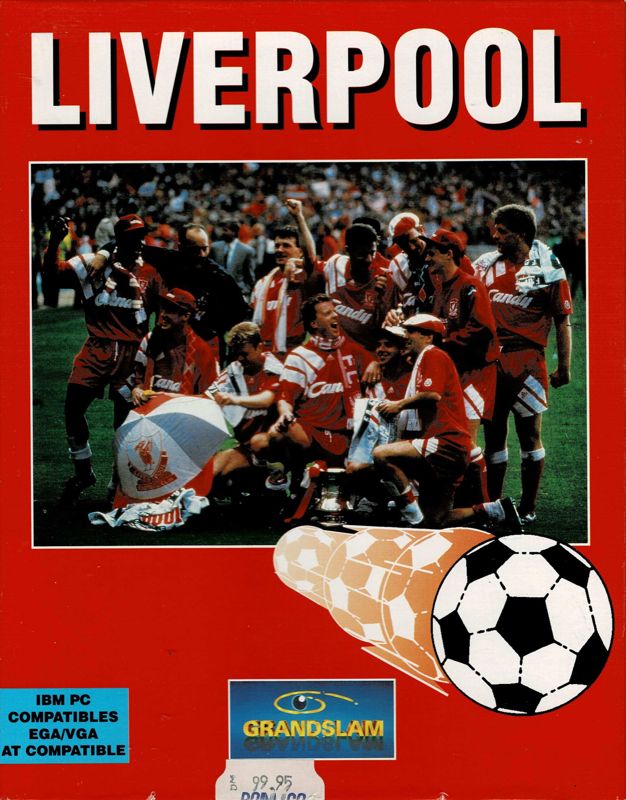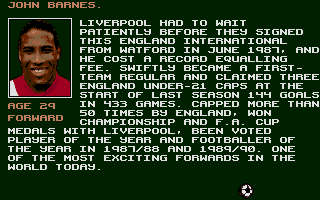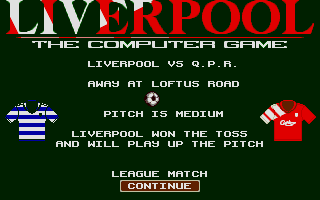Retro Replay Review
Gameplay
Liverpool: The Computer Game places you in charge of one of England’s most storied football clubs at the peak of its early-’90s dominance. You can choose from several modes—full league season, single match, two-player friendlies, or an FA Cup campaign. Each mode offers a slightly different pace and strategy: the season mode demands consistency and squad rotation, while the FA Cup run adds the tension of knockout football where every mistake could end your trophy hopes.
The on-pitch action employs a third-person 3D view very much in the style of Striker, showing only a small portion of the pitch at once. This tight camera angle fosters a sense of immediacy and allows you to appreciate individual player movements, but it also means you need to rely on the in-game scanner to track teammates and opponents across the entire field. Tapping the fire button switches control to the player closest to the ball—even if that player is off-screen—and automatically initiates a one-touch pass in the direction you’re holding the joystick.
The ball physics are forgiving: the ball “sticks” to your player’s foot, which helps mitigate the limitations of early 3D sports engines. Aftertouch is included as an optional feature, letting skilled players add curve or swerve to passes and shots. However, because the engine frequently snaps control to the nearest player, you’ll need to practice timing and spatial awareness to avoid mispasses or lost possession.
Graphics
Visually, Liverpool: The Computer Game wears its early-’90s pedigree on its sleeve. The polygonal player models are simplistic and monochromatic—every footballer appears in the same basic shape and color—yet they animate with a degree of fluidity that remains impressive for its era. Stadium textures are minimal, but you can clearly make out the famous Anfield stands and the famous “This Is Anfield” sign if you squint.
The split between the main 3D viewport and the radar-style scanner helps compensate for the restricted camera. While close-up dribbling and tackling happen in the main window, the scanner gives you a top-down schematic of player positions, allowing you to plan runs and passes even when the action is crowded. Color-coding for teams is distinct—bright white shirts for Liverpool versus darker kits for opponents—so you won’t lose track of which player you control.
There’s no crowd animation beyond a few blinking scoreboards and static banners, and pitch details such as grass striping are basic. But the sound design—crowd roars, whistle blows, and engine-score music—imbues each match with atmosphere. In many ways, the graphics are functional rather than flashy, serving the gameplay rather than stealing the spotlight.
Story
Technically, Liverpool: The Computer Game isn’t a narrative-driven title, but it does frame your campaign within the context of Liverpool FC’s storied history. In 1992, Liverpool had just clinched its last major trophy for nearly a decade, making each FA Cup run especially poignant. You’re essentially re-writing or extending that legacy, with every win reinforcing the club’s dominance.
There are no cutscenes or character arcs in the traditional sense, but each match carries the implicit drama of league title chases and knockout cup clashes. When you’re three points clear at the top or trailing in an FA Cup semifinal, the stakes feel very real. The only storyline beats come from the competition you face—upsets, rivalries, and the occasional underdog story when you meet a lower-league side in the cup.
Off the pitch, you can’t negotiate transfers or manage finances, but choosing your formation and lineup does give you a manager’s perspective. Do you stick with the tried-and-trusted 4-4-2 or experiment with a more adventurous set-up? How much squad rotation will you apply to survive a packed fixture list? These decisions create their own kind of narrative tension, weaving a makeshift story of triumph or failure across a single season.
Overall Experience
Liverpool: The Computer Game is an intriguing snapshot of early-’90s football simulations. It won’t compete with modern titles in terms of graphical fidelity or deep management systems, but it captures the essence of being in charge of one of England’s most iconic clubs. The blend of close-up 3D action with a strategic radar view makes for engaging, if sometimes challenging, match play.
For retro enthusiasts or longtime Liverpool fans, this title offers nostalgia and a chance to recapture the magic of Anfield in its golden era. Casual players will appreciate the straightforward controls and forgiving ball handling, while purists may find the lack of player differentiation and off-pitch depth limiting. Still, the optional aftertouch feature hints at the tactical possibilities that a more robust engine could have delivered.
Ultimately, Liverpool: The Computer Game stands as a testament to the early days of 3D sports gaming. It balances arcade-style fun with the seriousness of managing a top-flight team, and even if it’s rough around the edges, it remains an engaging way to lead the Reds to glory—or heartbreak—across a season or cup campaign.
 Retro Replay Retro Replay gaming reviews, news, emulation, geek stuff and more!
Retro Replay Retro Replay gaming reviews, news, emulation, geek stuff and more!









Reviews
There are no reviews yet.